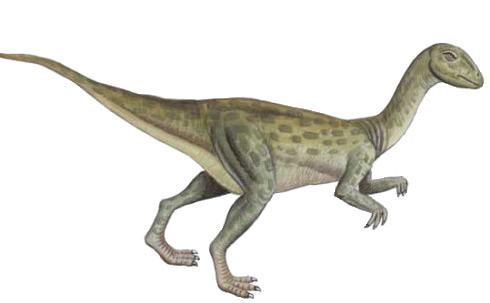
|
Search JoyZine with Google Site Search! |
Fulgurotherium
Fulgurotherium australe was a small ornithopod dinosaur from the Early Cretaceous of Australia. Fulgurotherium, known from Lightning Ridge in New South Wales and perhaps from Victoria, was one of the first Australian dinosaurs to be scientifically described. Lightning Ridge was on or near the palaeo-Antarctic Circle during the Early Cretaceous. This southern high-latitude position meant the area experienced extremes of daylight during winter and summer months, although the climate was much milder then than it is today. The now-dry Lightning Ridge area was then forested and close to the Eromanga Sea, an inland sea that covered vast areas of central Australia during the Cretaceous. Fulgurotherium, like most ornithopods, would almost certainly have been a plant-eater. Edible plants known from the Early Cretaceous of eastern Australia include ferns, horsetails and other low-growing Cretaceous plants. Fulgurotherium would have been adapted to survive in this extreme environment. Small ornithopods were remarkably common in Cretaceous Australia, particularly in southern Victoria, and may have traveled in small herds or flocks. Dinosaur burrows, possibly those of small ornithopods, were recently discovered in Victoria. Perhaps Fulgurotherium and other small ornithopods spent the coldest months of the year underground. Preserved tree branches, twigs and conifer cones suggest that the Lightning Ridge flora was fairly typical of Early Cretaceous Australia. Araucarian conifers and ginkgoes were probably the dominant forest trees. The understorey would have been comprised of ferns and cycads, and reeds and horsetails would have grown by the numerous waterways. The diverse fauna of Lightning Ridge included abundant molluscs, freshwater crustaceans, freshwater fish (bony fish and lungfish), turtles, crocodiles, dinosaurs (theropods, sauropods and ornithischians), pterosaurs, plesiosaurs, mammals and possibly birds. Southern Victoria during the Early Cretaceous lay south of the palaeo-Antarctic Circle and would have experienced even greater extremes of daylight than Lightning Ridge. Evidence for rafting ice on the Eromanga Sea and studies of cryoturbation structures from the area (deformations in sediments caused by the seasonal freezing and thawing of soils) suggest that the climate may have at times been quite cold, with winter ice and seasonally frozen ground. Evergreen araucarian conifers and podocarps and deciduous ginkgoes would have been important forest trees. The understorey would have included pentoxylaeans, ferns, bryophytes and mosses, and horsetails and reeds would have lined the streambanks. In Victoria, Fulgurotherium shared its habitat with other dinosaurs, fish (including lungfish), ancient labyrinthodont amphibians, pterosaurs, crocodyliforms and early Australian mammals (monotremes, ausktribosphenids and multituberculates). The original specimen (holotype) of Fulgurotherium is the distal end of a fragmentary, opalised femur. Other referred fossils from Lightning Ridge include a partial scapula, six additional femora (a seventh femur may represent a second ornithopod species), and a single tooth of the right size to be that of Fulgurotherium. Small ornithopod fossil material from Victoria (from both the Otway and Strzelecki Groups, Flat Rocks and Dinosaur Cove respectively) includes incomplete skulls and a partial skeleton, some of which may also be Fulgurotherium. Additional femora from Victoria have also been tentatively assigned to Fulgurotherium, but these vary in size and form and may represent at least three new genera. A study of additional Lightning Ridge ornithopod material identified several more femora that might be from Fulgurotherium, presenting a ‘composite femur’ built from these incomplete specimens. The size range is 1-1.5m long. Based on this composite, the femur of Fulgurotherium resembles that of hypsilophodontids, small ornithopods from the Jurassic and Cretaceous (reconstructions of Fulgurotherium have been based on Hypsilophodon foxii from the Early Cretaceous of Europe). Other isolated postcranial bones and teeth from Lightning Ridge are tentatively referred to Fulgurotherium although no skull, lower jaw or other associated fossils have been found. Several femora from the Early Cretaceous of Victoria are also referred to Fulgurotherium, although this collection seems to be a somewhat mixed bag of various femora, not all of which resemble that of Fulgurotherium. The status of Fulgurotherium is uncertain both because of its fragmentary nature and because the relationships of all Australian ornithopods are poorly understood. The original description of Fulgurotherium australe was based on the distal end of a fragmentary femur (upper leg bone) first identified as that of a small theropod. Fulgurotherium is now recognized as a small ornithopod rather than a theropod, although its affinities are still uncertain. |
